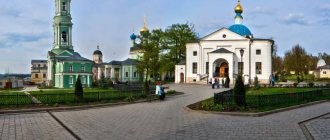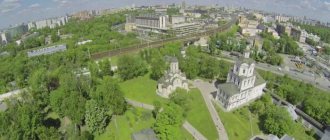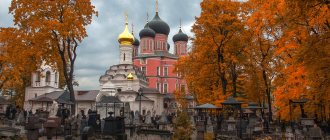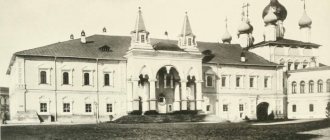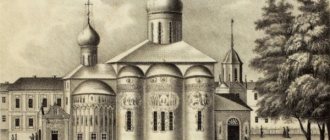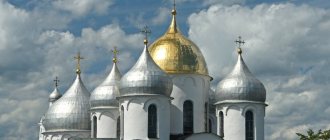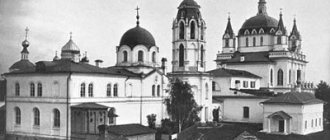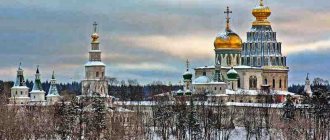One of the most beautiful sights of New Athos, and the whole of Abkhazia - Simono-Canonite Monastery for men.
It is located at the foot of Mount Athos, whose outlines resemble Old Athos. The place for the construction of the monastery was chosen in 1875 by Athonite monks from the monastery of St. Panteleimon.
The construction began near the temple of Simon the Canonite, where the holy relics of the apostle are kept, as well as the caves where, according to legend, he loved to retire to prayer.
History of construction
The monastery project was created by the architect N. Nikonov.
The construction was not easy. The scope of work included cutting away the rocky part of the mountain and clearing the site to the required size, while thousands of tons of rock and soil had to be removed from the area. The construction was also complicated by the fact that there was no convenient approach to the monastery, and the place itself was located at an elevation of 75 m above sea level .
The construction of the monastery was financed by monks from the Panteleimon monastery of the Greek Athos, for whom the tsarist government allocated significant financial subsidies.
Before it was completed,
the monastery was plundered during the Russian-Turkish War in 1878 , and in 1880 its active restoration began.
Emperor Alexander III also took part in this, donating musical chimes to the monastery. They still decorate the monastery, towering on the highest monastery tower.
Donations were also accepted for the monastery, and in 1900 the construction was completed - on September 28, the monastery was consecrated and became one of the most significant spiritual centers in the Caucasus, until the October Revolution.
From that moment on, difficult times began. During the years of Soviet power, it was used as a warehouse, a local history museum, or a military hospital. Divine services at the New Athos Monastery in Abkhazia resumed only in 1994. The men's church choir began to sound, the economy began to improve, and a church school opened.
Historical information about ancient Athos
The New Athos Simon-Kananitskaya men's monastery was officially founded in 1875 by monks from the Panteleimon Monastery, located in the Greek old Athos.
Ancient settlements on New Athos in Abkhazia have been known since the 3rd century as trading centers where ships with goods entered. Based on the development of trade and economic relations, the settlement developed and grew rich.
New Athos Monastery, Abkhazia
- In the 4th century, a fortress was built here on Mount Iberia for city defense, inside which a temple was erected to the Apostle Simon the Canaanite, a saint who lived in the first century and died at the hands of Roman soldiers. According to legend, it was thanks to the protection of the Iveron Icon of the Mother of God that this area was liberated from the Arab invasion.
- Anakopia in the eighth century was the capital of the region and the residence of the nobles of Georgia and Ossetia.
- In the 14th century, the Genoese began to develop this region, a Roman watchtower appeared, and the entire internal complex of the fortress was modernized, because Christianity took root among the local population.
- In the 19th century, the tsarist government allocated funds for the construction of a monastery on the site of ancient buildings and the cave of Simon the Canaanite.
It was no coincidence that the Athonite elders chose this place. In the Anakopia fortress, before the construction of the men's monastery complex on New Athos, services were already held in two cathedrals, for more than half of the population were Christians. Hermits lived in mountain grottoes and caves. Apostle Simon the Canaanite in Abkhazia is called the stepson of the Mother of God.
New Athos complex
The monastery complex has always stood out for its architectural merits.
Compared to other monasteries, it is a grandiose example of the neo-Byzantine style. In the center rises the Panteleimon Cathedral, decorated with five domes, the tallest of which is 40 meters in height.
In addition, the monastery complex contains several more church buildings: the Gate Church of the Ascension of the Lord, the temples of the Martyr Jerome and the Mother of God, the Holy Apostle Andrew the First-Called and the Venerable Elders of Athos.
Believers come to venerate the miraculous cross of the monastery, and in the northwestern part there is a refectory, the walls of which are decorated with frescoes. The royal alley, lined with cypress trees, reminds of the meeting of the emperor and the abbot of the monastery; there is a small chapel right there.
Shrines and relics
The New Athos Monastery in Abkhazia contains many shrines:
- relics of Simon the Canaanite;
- icon of St. Panteleimon;
New Athos Monastery in Abkhazia, icon of St. Panteleimon. - a piece of the relics of St. Andrew the First-Called;
- a piece of St. Andrew's robe;
- Image of the Mother of God “Deliverer”;
- a particle of the relics of the healer Panteleimon;
- a particle of the relics of the holy martyr Clement;
- Image of the Mother of God “Anakopia”;
- a piece of the Tree of the Honorable and Life-Giving Cross of the Lord;
- The image of the Mother of God “Pitsunda”.
How did they live before the revolution?
In 1902, the monks of the monastery built a hydroelectric power station with 120 horsepower, and they also built the New Athos pier, which received cargo and passengers.
The monastery even had its own railway , which was given to it by Emperor Alexander III; it was successfully used by novices to transport various types of wood and other goods necessary for the monastery.
The monastery also received the rights to economic activities: there were candle factories, an oil mill, a horse factory and a brick factory. Fruits and citrus fruits were grown in the gardens, and the novices of the monastery taught literacy to local boys.
The monastery was a major religious center on the Black Sea coast of the Caucasus. It was dedicated not only by religious pilgrims of all classes, but also by representatives of art and literature, including M. Gorky and A. Chekhov.
Reasons for starting construction
In mid-1874, the Archpriest of the Holy Mountain and the Greek clergy decided to close the Russian Athos Panteleimon Monastery. Everyone in it had to leave for Asia Minor, where an empty Christian monastery remained. However, the abbot found out about these plans in time. To save the court, he wrote a letter to Count N.P. Ignatiev, the Constantinople envoy. In the dispatch, the monk asked to petition Emperor Alexander II for the provision of a plot of land in the Black Sea region, which would belong to the Orthodox diocese, for the improvement of the monastery.
Hieromonk Arseny, a resident of the Panteleimon Church, was assigned to select the location where the Athos Monastery would be located. He found a site where, as legend says, the painful death of Simon the Canonite, one of the apostles, occurred, and the outline was similar to a Greek mountain. This region is also known for the fact that the city of Anakopia, which was previously the capital of the Abkhazian kingdom, was built here.
In November 1875, Tsar Alexander II ordered to provide the required amount of land and transfer to the monastery the ruins of the Church of the Apostle Canaanite, as well as the Genoese tower. The brothers were given the right to fish in the Psyrtsha River. And by the end of the year, the arriving craftsmen and brothers who had experience in construction, under the leadership of the talented architect Hieromonk Hieron, began the construction of the monastery.
Monastery today
Today the New Athos Monastery is not only a shrine, but also a unique cultural monument. A religious school has been opened here since 2001 .
The brotherhood is headed by Hieromonk Andrey, ordained a priest in 1997. In the 70s of the last century, water began to seep into the basements of the monastery, the foundation and walls began to collapse, and the drainage systems were disrupted.
In 2008, Russia provided financial support to the New Athos Monastery and the restoration of its drainage system began.
Repair and restoration work continues today; the interior, facade and various buildings on the territory of the monastery are being restored.
Decline and rebirth
After the advent of Soviet power, the monks defended their right to life and service in the monastery. However, under the pretext of anti-Soviet agitation, the parish closed in 1924. Economic work stopped, the power plant and railway communications stopped. The cable car was also destroyed.
Later, the territory of the monastery was used as a tourist base, and the cathedral was used as a local history museum. Where the abbot lived, a Stalinist dacha was built, and next to it was the house of L.P. Beria. There is a legend that it was Joseph Vissarionovich who forbade the demolition of entire buildings. He warned that the situation could become tense among the Orthodox Abkhazian population.
Further events developed as follows:
- Serious collapses occurred in the 1970s. The drainage system was disrupted and one of the monastery walls was washed away. To preserve this unique architectural monument, huge amounts of money were required.
- During the Georgian-Abkhaz war of 1992-1993, the hospital located in the building was subjected to shelling, which damaged all the buildings.
- Since 1994, the country learned the news - services began in the New Athos monastery, and pilgrimage was revived.
- 2001 - opening of a theological school and school of regents.
- 2008 - the drainage system was restored. The work was carried out with funds transferred from Russia.
- 2009 - installation of new domes on the main cathedral.
- 2010 - restoration of the facade, buildings and restoration of the interior.
- On May 26, 2011, clerics Father Andrei and Dorofey were recognized as schismatics and were banned from serving. Since there was no repentance for the schism, these brothers were suspended for another 3 years. In response, the accused renounced the Russian Orthodox Church.
How to get there
The monastery is visible from anywhere in New Athos , and the city itself can be reached from any resort town in Abkhazia by bus or minibus.
From the border with Russia to New Athos – 85 km, from Sukhum – 21 km (20 min drive). Conventionally, the city of New Athos is divided into a historical and commercial part. The historical part contains most of the local attractions.
It is convenient to follow the New Athos Monastery from the “Shell” stop near the central square , from where two roads depart - one to the New Athos cave and the monastery, the other to the waterfall and again the monastery.
GPS coordinates: 43.087407:40.820955. On one side the monastery is protected by the mountains of the Caucasus Range, on the other there is a picturesque steep slope to the seashore.
Where is the New Athos Monastery located?
First you need to get/fly to Adler by any means convenient for you (I wrote more in the article “What is the best way to get to New Athos and where to rent housing?”). From the station or Adler airport, take bus No. 173 (other buses and minibuses stop far from Psou, you will have to walk for a long time, but this route goes straight to the border), the ticket costs 25 rubles. To cross the border, you only need to have a Russian, Ukrainian or Belarusian passport, a birth certificate for each child and an exit permit from the second parent.
After passing the checkpoint, you will find yourself at the bus station site. Do not respond to numerous offers from all sides from Abkhazians, go straight to the buses and minibuses. Take the most crowded transport (to New Athos or to Sukhum). The ticket price will cost 150-200 rubles. Well, you can get there by minibus in 1.5-2 hours, and by bus it takes about three hours. Tell them to stop you in the center near the church or Seaside Park!
Seaside Park, where there are 7 ponds
Get out of the transport and go behind the church, or rather the chapel in memory of the soldiers who died in the 1992-1993 war. Cross the road to the shops and see signs (turn left to the caves, turn right to the monastery). Along the way you will meet several more signs until you find yourself on the sinner's path, paved with cobblestones. Now begins the difficult climb up the mountain to the New Athos Monastery. They say that if you walk this trail on your knees, you will atone for your sins. The ascent will take about half an hour; along the trail there are tents of traders, who I assure you have the “cheapest price”. This is not so, pass by, it’s better to go to the market later.
The entrance to the monastery territory is real, because it is active and is not a museum.
Beautiful scenery from the site near the New Athos Monastery
If you decide to purposefully go to Abkhazia to visit the monastery, then choose guest houses located on a hill away from the beaches, so you will save twice on housing. The average room rate per night is 600 rubles.
Practical information
The monastery is open to visitors every day, from 9 a.m. to 8 p.m.
On Sundays and holidays, services are held here, and then the monastery opens its doors at 7 am. Here you can:
- perform the baptismal ceremony (by prior arrangement);
- get married (only for residents of Abkhazia);
- confess;
- come to an appointment for spiritual issues.
The stand at the central entrance to the monastery will tell you more about these procedures, or you can contact the servants by phone.
You can take photographs and videotapes on the territory of the monastery, but do not use flash.
The heyday of the monastery
For almost 30 years - the 1890s and the period from 1900 to 1917 - the heyday of the monastery continued. Then the monastery became famous for its charitable activities. Other monasteries received icons, church utensils and books from New Athos - as the city began to be called in 1875. Free food and medicine were distributed to low-income citizens of Abkhazia. A men's school for Abkhaz orphans was opened on the territory of the monastery. The monastery turned into a major center of spiritual life in Russian Transcaucasia.
There were farmsteads of the New Athos Monastery in several Russian cities: St. Petersburg, Yeisk, Sukhum, Tuapse, Pitsunda and Novorossiysk. Three decades 1890–1910s marked by important events related to the activities of the monks of the monastery:
- two cable cars were built: to Mount Athos and Mount Iveron;
- a waterfall was built near the temple of Simon the Canaanite;
- There was a large garden around the monastery where pears, bananas, oranges, apples, tangerines and other fruits grew;
- honey was produced in two apiaries;
- the swampy valley of the Psyrtskhi River has been cleared;
- a system of ponds and canals was built;
- more than 10 workshops have been opened: turning, carpentry, weaving, foundry, leatherworking, bookbinding, blacksmithing and others;
- built its own narrow-gauge railway;
- Potatoes and corn were grown in the monastery gardens, and wheat in the fields;
- A small power station was built.
Reviews
Gennady, Pskov
“I would not recommend overpaying for an excursion to the monastery. Getting to New Athos is not a problem; minibuses from Pitsunda, Gagra and Sukhum run regularly, and the monastery itself is located right in the city center and is visible from everywhere. Taxis greatly inflate the actual fare, so it's worth bargaining. Not far from the monastery there are small boarding houses and hotels where you can stay if you want to spend a couple of days here.”
Maria, Ust-Kamenogorsk
“The New Athos Simon-Canonite Monastery in Abkhazia is very beautiful and surrounded by gardens and vineyards. The area is very picturesque. True, from the inside it is noticeable that only its outer part has been restored so far, paint has fallen off the walls and ceilings in some places, some rooms are quite shabby, but this does not detract from the greatness of the monastery, especially since the repair work here does not stop.”
Lyudmila, Kaluga
“The historical part of the city of New Athos is not burdened with multi-storey buildings; there are no tall buildings here, only private buildings. There are also few grocery stores, on the square and also near the Museum of Military Glory. There is more than one road leading to the monastery, but in any case you need to overcome a rather steep climb. Before entering, you are given headscarves and linen to tie around instead of a skirt if the woman is wearing trousers. There are a lot of tourists."
Watch a video about the New Athos Monastery
While vacationing in Abkhazia, be sure to visit the main attraction - the New Athos Caves. The schedule of excursions, descriptions of the halls and much more are in an interesting article. Read our story about the sights of Pitsunda, about historical monuments in Abkhazia on this page. Find out about the beauty of Tesheb waterfalls and their healing properties from our review.
Rules for visiting the monastery and opening hours
We recommend visiting the monastery from May to September. The opening of the temple during this period is at 9:00. In cold months - at 12:00. The entrance to the monastery territory closes at 20:00 in summer and at 18:00 in winter. Visiting temples and cathedrals will not require any expenses. If desired, guests can purchase souvenirs in the shopping arcades, which occupy a large space, starting on Cypress Alley halfway to the main entrance. Visitors must follow simple rules when visiting churches and walking around the territory of the New Athos Monastery:
- women should cover their heads with a headscarf or headscarf;
- the dress or skirt must cover the knees;
- men are not allowed to wear beachwear: shorts, sleeveless T-shirts;
- Taking photographs with a smartphone or camera, as well as filming videos, is permitted throughout the territory.
Those who get hungry on the way to or from the monastery can buy mineral water, pastries, fruits, soft drinks and beer in the shopping arcades.
How to get to the monastery?
New Athos is a compact city, despite its venerable age. It was founded in the 3rd century, but was never able to grow to impressive sizes. The path to the monastery starts from the bus stop near the Museum of Military Glory, which locals call “Shell”. Tourists have to walk approximately 1.2 km:
- past Primorsky Park on the street. Lakoba to the first traffic light;
- left turn;
- road to the Intercession Church;
- then the path lies along Cypress Alley (the second name is “the path of sinners”);
- the path goes past shopping arcades;
- Cypress alley ends at the main entrance.
The journey will take about 15 minutes. Some tourists visit the New Athos Monastery along with excursions. Most travelers prefer to explore the monastery on their own. The visit usually lasts 3–4 hours. A guided tour is much faster, but less interesting.
Pilgrim page. Stories about holy places.
There are holy places in the world that can be called icons of other – great – shrines. New Jerusalem near Moscow, New Athos in Abkhazia... New Athos Monastery
, which gave its name to the surrounding area, was established in 1875 by monks who came from the Russian St. Panteleimon Monastery on Athos.
The place for the monastery, on behalf of the Athonite elders, was chosen by Hieromonk Arseny (Minin)
, a resident of the Panteleimon Monastery, who obediently spent many years in Russia, the founder of the famous Athos Chapel in Moscow before the revolution, buried in the cemetery of the Novo-Alekseevsky Monastery. The place on the mountains of which the holy monastery appeared has an ancient history. Even before the birth of Christ, the village of Pstsyrkha was located here (the name means “Fir Spring” and was borrowed from a mountain river flowing nearby). In the Middle Ages, an impregnable fortress of Anakopia was built on a mountain near Pstsyrkhi (this name comes from the Abkhazian “anakop” - ledge), which was the capital of the principality of Abazgia, and then of the Abkhazian kingdom (also known in Byzantine sources as Trachea).
In the first century, the apostles Andrew the First-Called and Simon the Canaanite preached here .
The Apostle Andrew went to continue his preaching to the north, reaching Kyiv, and then the island of Valaam. And St. Simon the Canaanite remained in Pstsyrkh, settling in a stone cave not far from the village. Many residents accepted faith in Christ according to his word, but others, having become hardened, crucified the preacher on the cross, and he accepted a martyr’s death in imitation of the Beloved Savior, for Whom he worked. Apostle Simon the Canaanite is the same man at whose wedding the Lord turned water into wine. Struck by this miracle, and even more so by the very personality of the God-man, Simon left his family home and followed Christ, becoming one of His twelve Apostles. For his zeal for Bose, he was called Zealot, which means “zealot” (the name Canaanite indicates origin from Cana of Galilee). The cave where St. labored. Simon Zelot, located in the gorge of the Pstsyrkha River (behind the waterfall and the Pstsyrkha railway station). The place of the apostle's martyrdom is indicated by a stone cross on the river bank. Over the grave of the saint in the 6th century. A beautiful temple was built, which has survived to this day.
In 736–738 Through the intercession of the Most Pure Mother of God, the Orthodox inhabitants of Anakopia managed to repel the invasion of the terrible Arab conqueror - Murvana-Kru, whose name translated means “deaf” - as he was named for his merciless cruelty towards the conquered peoples. Murvan-Kru passed through the Caucasus like a deadly whirlwind, conquering and ruining the Georgian lands: Kartli, Egrisi. Therefore, not only the inhabitants of its surroundings, but also the Georgian king Archil and his brother Mir found refuge in the Anakopia fortress. There were 3,000 defenders of the fortress, about 60,000 attackers. The defensive structures of the fortress consisted of three rows of powerful walls with towers encircling the mountain at different heights (some of them have survived to this day), a source of clean water allowed the defenders of Anakopia not to suffer from thirst . But the main strength of the courageous Anakopians was the true – Orthodox – faith. They prayed tearfully before the image of the Most Pure Mother of God, and the Zeal Intercessor did not despise the prayers of the Christians. An epidemic of bloody cholera began in the camp of the besiegers, from which 35,000 people died in one night. After this, the Anakopians managed to completely defeat the enemy, who still outnumbered them and had hitherto been invincible to anyone. The image of the Anakopian Mother of God, through prayer before which this miracle took place, was revered as miraculous. It remained in New Athos until the twentieth century, and then disappeared from the eyes of believers, carried away by a terrible whirlwind of godlessness destroying the shrines.
| Nature of New Athos. Photo: Malyutina E. |
So why exactly was Pstsyrkha destined to become New Athos?
The nature of Abkhazia is very similar to Greece. Lush subtropical vegetation, a warm climate, the soft outlines of mountains covered with impassable forests and harsh rocks, an abundance of water... Together with the solitude and pristine untouchedness of nature, all this contributed in the best possible way not only to the creation of the “icon” of the Athos Monastery in the Russian Empire, but also to the solitary residence of hermits . Anakopia at that time was a small, barely noticeable village. Having come here, the monastics ennobled and transformed the wilderness for the glory of God. The swamps were drained, tangerine orchards were planted (it is to the New Athos monks that we owe the famous Abkhazian tangerines - before that, citrus fruits were not grown in the Caucasus). The area was decorated with olive groves, and ponds appeared on the seashore where delicious fish were bred (today they serve only a decorative function). For local boys, a school was opened at the monastery, for visiting pilgrims - a hotel near the sea (it survived all the hard times and is still in operation today, it’s a pity that it does not belong to the monastery. Today it is the Abkhazia Hotel. By the way, in 1888 in one of its rooms where the famous Russian writer A.P. Chekhov stayed). The hotel is attached to an even more ancient architectural monument - a tower from the 11th century - the only fortification preserved from the ancient coastline. The dominant feature of the area was the building of the monastery, towering against the backdrop of a mountain covered with southern greenery, consecrated in the name of the Apostle Simon the Canaanite. Their architecture raises the mind to the monasteries of Athos.
| New Athos Monastery. Photo: Malyutina E. |
The main temple of the monastery is dedicated to the great martyr and healer Panteleimon, the patron saint of the Russian Athos Monastery.
Also in the monastery churches were built in the name of the Apostle Andrew the First-Called, St. Hieron, Ascension of the Lord. The interior decoration of the Panteleimon Church at the same time resembles Athos and does not let us forget that we are still within the Russian Empire. Along the walls there are carved wooden stasidias, and from the vaults of the temple, faces painted in the Vasnetsov style look down on the worshipers - the church was painted by Moscow artists under the direction of N.V. Molova and A.V. Serebryakov and the Volga Bogomaz artel, led by the Olovyannikov brothers. The huge cathedral of the monastery today is rarely filled with worshipers, but before the revolution, 730 brethren labored in the New Athos monastery. The mountain on which the monastery raised its heads to the sky was named Athos, and the one adjacent to it, the same one on which the remains of the Anakopia citadel are located, was named Iveron - in honor of one of the main shrines of Athos. The construction of a temple and a hotel for pilgrims began in the ancient fortress, but was not completed due to the disaster of 1917. The walls of the 7th century temple have also been preserved. Today, among the ancient ruins, there is a lovingly decorated chapel, where you can light a candle in front of the image of the Iveron Mother of God and read the akathist to the Most Pure One. The source treasure, revered as a saint, has also been preserved.
The technical achievements of the organizers of the New Athos Monastery are amazing
So, for the convenience of climbing the Iveron Mountain (its height is 344 meters), the monks built a cable car, which was later destroyed by the revolutionaries. Today you can climb the mountain on foot, the journey takes about an hour. A fairly convenient serpentine road, half asphalted, leads to the top, starting from the New Athos karst cave (not to be confused with the cave of St. Simon the Canaanite!)
Working under the guidance of specialists, the monks (at the very beginning of the twentieth century!) created their own hydroelectric power station, for which they built a dam on the Pstsyrkha River (this is how a waterfall appeared, which to this day attracts guests of New Athos). The waterfall was also used as a kind of refrigerator - ice was placed in the cave, protected from the sun by its cold streams, in winter, which did not melt all summer. There was a brick shop, a watch shop, a foundry shop, a painting shop, a bookbinding shop, etc. workshops. In 1888, New Athos was visited by the Sovereign Emperor Alexander III with his Heir, Tsarevich Nicholas
(future Tsar-Martyr Nikolai Alexandrovich). After praying at the monastery, visiting the cave of the Apostle Simon the Canaanite and inspecting the monastic household, the Emperor and the Heir sailed on their own yacht to Novorossiysk. Upon returning from this journey, an attempt was made on them, but the Lord preserved His Anointed One. In gratitude for deliverance from danger, the Emperor gave the New Athos Monastery a steam locomotive. It was useful to the monks to perform an important obedience: transporting valuable wood from the high mountains surrounding the monastery. For this purpose, the monastics laid a narrow-gauge railway to the top of Mount Athos. The accuracy of the calculation was such that the carriages loaded with timber rolled smoothly to the coast without additional traction, while the empty train was pulled up the mountain by a steam locomotive donated by the Tsar. This historical train is still one of the attractions of New Athos today. The road leading to it starts from the monastery.
| View of Iverskaya Mountain. Photo: Malyutina E. |
A considerable part of the first inhabitants of the New Athos monastery were monks expelled from Old Athos as a result of the notorious Athos Troubles (disputes around the Name of God).
Without going into an analysis of the discussion, we will only say that the composition of the inhabitants expelled from Athos was by no means homogeneous. Among them there were also ardent defenders of name-glorification, and there were also restless souls, always striving to argue, rebel and denounce. But there were also simple-minded monks who clung to the Jesus Prayer with all their hearts and were simply afraid to offend the Lord by signing, as the fighters against name-glorification demanded, a paper denying that the name of God is God. (You can read more about this in the book of Archimandrite Raphael (Karelin) “On the Path from Time to Eternity”, pp. 303 – 324). The best spiritual traditions of Athos were in effect in the New Athos Monastery, such as the elder care of monastics (according to the Greek tradition, an elder is not a bearer of special grace-filled gifts (insight, etc.), but an experienced confessor who leads children who have trusted in unconditional obedience to him along the path of spiritual life). The inhabitants of the monastery were engaged in mental work - the Jesus Prayer. In the vicinity of the monastery, among the deserted mountains, hermits labored.
The revolution that broke out in 1917 brought ruin and closure to the New Athos Monastery, and many of its inhabitants received martyr's crowns. According to legend, the atheists took the monks on a ship to the middle of the New Athos Bay and drowned them, tying heavy stones around their necks. They say that in our days divers saw the incorrupt bodies of martyrs standing at the bottom of the sea. Monastic robes and beards sway with the quiet current... So, the water of New Athos Bay is holy - sanctified by the suffering feat of those killed for their faith. The monastery was closed in 1924. Not far from it, one of Stalin’s many dachas was built (today, part of its territory - the building where the guards lived - is occupied by the boarding house "At the Monastery"). The monastery premises housed a tourist center and a local history museum.
But spiritual life in the vicinity of New Athos did not die. Hermits continued to escape in the deserted mountains. During the years of state atheism, their number increased: with the almost complete absence of monasteries, the Caucasian “desert” sheltered those seeking prayerful solitude from all over Russia - both men and women. In the seventies of the 20th century, the famous Glinsky elder Schema-Archimandrite Seraphim (Romantsov) came to care for the hermits.
settled after the closure of his native monastery in Sukhum.
New Athos was visited more than once by another one of the ascetics of the 20th century, Schema-Abbot Savva (Ostapenko).
| Church of St. John Chrysostom in Comana. Photo: Malyutina E. |
Schema-abbot Savva is credited with finding the lost site of the third discovery of the head of John the Baptist.
This place is a small cave near the village of
Kaman.
It was here in the 9th century that the Orthodox hid from the iconoclasts a great shrine - the Honest Head of the Baptist of the Lord.
But this is not the only thing that makes Kaman famous. martyr Basilisk
suffered here and a hundred years later it was in this village that the great
saint John Chrysostom, dragged into exile by merciless soldiers, gave up his spirit.
Exhausted by the difficult journey, illness and cruelty of his companions, who did not allow him to rest his exhausted body, the saint, on the eve of his death, saw in a vision Saint Basilisk. “Tomorrow we will be together!” - the martyr predicted to the sufferer. With the words “Thank God for everything!” St. John gave up his soul in the hands of God and was buried in Kaman. His stone sarcophagus is still reverently kept in the Kaman Church, and the relics of the saint, 30 years after his departure from earthly life, were honorably transferred to Constantinople, to the place of service of St. John, Emperor Theodosius is the son of those who sinned against the saint of God Eudoxia and Arkady. Excursions to Kaman are conducted by the New Athos travel agency, you can also use the services of a taxi driver, but in rainy times the road to this holy place is difficult due to rising water in the mountain river through which you have to cross.
In 1994, the revival of the New Athos monastery began.
Some of the buildings have been restored, and services are held on Sundays and holidays. On Mondays and Tuesdays, unless there are holidays on these days, the monastery is closed to visitors. It is gratifying that the monastery has good traditions of spiritual life: frequent communion of the Holy Mysteries of Christ is encouraged, the priesthood encourages parishioners to read spiritual literature and the Jesus Prayer. One of the main shrines of the monastery is a particle of the relics of the Great Martyr. Panteleimon, located in the icon of this saint, usually lying on a lectern in the center of the temple.
Those who come to rest and pray in New Athos can settle down
in one of the hotels, in the boarding house “At the Monastery” (its disadvantage is its location high above sea level and the service, reminiscent of Soviet times at quite modern prices, its advantage is its close proximity to the monastery: the gate of the boarding house goes directly to the outer monastery courtyard). There is a wide choice of accommodation options in the private sector: you can rent a room in a small house or an entire apartment in one of the five-story buildings located on the coast at the end of the city (towards Sukhum) (and the difference in price is not great).
Several practical recommendations for guests of New Athos.
It is best to purchase fruits and dairy products at the market located at the end of the city (among the five-story buildings) on the street.
Lakoba. The market is open for only 2 hours, from 6 am. By eight, the traders sell their goods and leave. Grocery stores with reasonable prices are located in the same part of the city, but in the tourist center (near the monastery and the waterfall) you can only buy fruits and delicacies at two to four times the price. The tourist office is located on the main square of New Athos - Freedom Square.
Get to New Athos
You can get to Adler, and from there to the border (Veseloye village) by minibus. They cross the border on foot, for which it is enough to present a passport and pay a fee. The walking route across the border is about a kilometer; porters with wheelbarrows offer their services. Buses depart from the border to the coastal cities of Abkhazia (Gagra, Pitsunda, Gudauta, New Athos, Sukhum).
Internal traffic in Abkhazia
done using minibuses, buses and private taxis.
There is no bus station in New Athos, so you have to “catch” transport on the highway. The beach in New Athos is pebbly, the strip of shallow water is not wide. During the season, awnings are stretched on the beach belonging to the boarding house “At the Monastery”; there are also sun loungers there. The holiday season in New Athos begins in mid-June. Entrance to the beach is free. There are also many “wild” beaches. There are many cafes in the city that serve, in particular, very tasty fried Black Sea red mullet fish, and for some reason the kebab has a smoked taste. Near the Abkhazia Hotel there is a library, which vacationers can use for a small fee. Next to the library there is a warm church in the name of the Intercession of the Most Holy Theotokos,
services in which are performed mainly in the cold season.
Another interesting place in New Athos is one of the largest and most beautiful karst caves in the world.
The cave is landscaped, excursions are held there (in June 2008, the ticket price was 300 rubles). The constant air temperature in the cave is +12 degrees Celsius.
